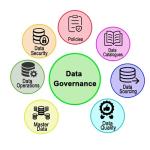In this video presentation, Autodesk’s Finance Director Valerie Martin offers insights on how to ascertain what...

It’s a question many of us ask ourselves when assessing our business decision-making quality. While many organisations pride themselves on their ability to break from the restraints of indecision and quickly move forward with a course of action, only the truly best in class have a strong hold on what data matters, how to interpret it, and what to look for moving forward.
As an FP&A veteran, I have seen several different levels of maturity, both in terms of understanding data and intent to use it in a company’s decision-making. Some companies think they are data-driven just because they produce a lot of data and sum it up in a report. Some believe being data-driven requires a ‘Big Data’ mindset and capability with special training and tools. Neither is necessarily the case. Being ‘Data-driven’ is really a spectrum on which all companies sit, with some having better maturity while others are not ‘Data-driven’ at all.
It is the FP&A professional’s responsibility not only to produce data (or reports) for the organisation but to turn that data into ‘info’ that can be used to identify and diagnose issues, call out trends, or expose opportunities that the organisation can consume, use, and act on.
All companies have several ways to reach their decisions; some are very data-based, but most are based on several other dynamics.
How Does Your Organisation Make Decisions?
There are several different ways in which companies make decisions:
-
Art (Gut)
Many organisations will make decisions based on their ‘gut’ instinct. This is often due to the absence of good information to use. This method also offers the comfort of moving fast without taking the time to collect, interpret, and analyse the data.
In my career, I have encountered several leaders who prefer this decision-making style. The best thing an FP&A Business Partner can do in this scenario is to work on supporting the decisions with data, complementing decisions being made. Or in cases where the decision flies in the face of the data, it is best to ensure you are organised enough to have the data in time to engage the decision-maker before their heart is set in one direction or another.
-
Highest Paid Person
This is when everyone defaults their decision to the highest-ranking person, who may or may not use data in their decision-making. We see this in many organisations with poorly defined decision rights, as well as poor data and info integrity, meaning that the only decision made with any confidence is the one made by the highest-paid person.
-
Collective Reasoning
While collective reasoning has positive and negative aspects, too much of it can often lead to a ‘group think’ or perpetual indecision.
While soliciting different points of view and considering all angles of a particular decision set, there is a much better chance of relevant data or information entering the conversation. However, there is a term called ‘analysis paralysis’, which refers to a state that can arise when too many decision-makers want to continue looking at different data cuts.
FP&A professionals are well served in this case to ensure that KPIs and measurement of tests are well defined and that pre-determined actions are discussed in connection to different possible results.
-
Passive
Often, some of the worst decisions are made through passive decision-making. This is where the decision is made to take the path that offers the least resistance or requires the least resources/energy.
Relevant information or data is only sought out if it supports those paths to manipulate the decision maker’s thinking that this is a well-thought-out decision, even if it is not.
-
Data-Driven Decisions
Large or small amounts of data are used to diagnose issues, draw correlations or trends, and predict potential future outcomes. This needs to be done in a very organised and thought-out way.
This latter decision-making style can be used to complement all of the other methodologies. However, watch out for “pretenders”. “Pretenders” like to think that producing a report, or the presence of data, means they are making a data-driven decision. This is usually not the case. The data needs to be analysed, and the organisation must have a good idea of what the data or info is telling them and then use it to guide their next course of action.
I remember one organisation I worked with when the film ’Money Ball’ came out. This organisation simply thought that producing a report with lagging indicating KPIs, which only partially reported on results and didn’t connect or correlate any actions to results, was equivalent to what was done in this movie. So, they called their report the Money Ball report.
Money Ball was a movie about a true story in which one of the financially poorest major league baseball teams found a way to compete by analysing their data differently. In the film, they looked at less traditional metrics as leading indicators that could make them successful. They then acquired players who were cheaper in the open player market and whom they knew would complement those metrics, giving them an advanced chance at winning.
The organisation I was with at the time was convincing itself that the mere creation of data in a report and reviewing it weekly was giving them an upper hand in data-driven decision-making. However, they never changed anything they were doing or drew any correlations between results and actions. They simply read the reports and kept doing everything they always had.
As I mentioned earlier, many organisations think the resources needed to be data-driven are too costly, both in terms of expensive tools and the need for highly skilled data scientists. This is not true. Any organisation can be data-driven. There are several steps any company can take to enable it to move from having hardly any data considerations at all to making highly informed decisions with meaningful data and info.
The Data Spectrum

Figure 1
Many organisations may have no data capture or very sporadic data. This is the first hurdle to overcome. Incomplete data will only give you a partial idea of what you are dealing with and never full confidence to move forward in your decision-making.
Once an organisation has its full data aligned, it needs a capability, either through tools or manually, to convert that data into info. For example, having sales and inventory data that is well attributed in a retail company that is hundreds of thousands of lines long would signify excellently aligned data. However, the data will not be very informative if there is no methodology to filter or select data from a set relevant to a particular decision. This is where the saying ‘Data Rich, but Information Poor’ comes from. An organisation must have a suitable method and/or tools they can use to extract meaningful information from their rich data sets.
Suppose an organisation does a good job of converting its data into information. In that case, the way that information will be perceived and interpreted must also be well-organised and aligned to influence future decision-making. This can often be done by ensuring that KPIs or expected measurement outputs are well integrated and accepted into FP&A forecasting models or business case measurement processes.
Ensuring alignment and understanding upfront always enables an organisation to be as agile as possible in its decision-making. In many circumstances, it is not entirely possible, however, as often the information that comes doesn’t always give a clear picture. In this case, the FP&A professional may need to work with the business to think of other angles or interpretations they might draw from the data.
Steps to Become More Data-Driven
- Understand your KPIs & ‘Drivers’: Understanding which KPIs matter and which elements drive your business is paramount. Once you properly understand this, your organisation can ensure it captures the relevant data and adequately attributes it in its data capture systems.
- Ensuring You Have Clean/Complete Data: Ensuring that definitions of data from different systems are aligned and complete is essential to confidently making decisions and keeping ‘one version of the truth’. Disparity across data systems leads to low confidence in the data used for decisions. It can often result in abandoning the pursuit of using data/info in the decision-making process.
- Reporting Data into Consumable Formats: Once you have good data, it is not good for anything if it cannot be consumed well. There must be a methodology, either manually or through BI tools, that allows the data to be transformed into usable information.
- Integrating Data into FP&A processes: Useable information is not useful if it has nowhere to be used. It is important to figure out what data you need, how it will factor into the different models, and the analysis that will be conducted on existing or new FP&A processes.
- Understanding when you need specific information in the decision-making process (Lagging vs Leading information): Depending on the decision, it can be made tomorrow or 10 months from now. Understanding whether there is a need for leading information or whether lagging information will best serve a decision can make all the difference.
How Do Tools Support Data-Driven Decision-Making:
Once an organisation has climbed the various steps to being more data-driven, having the right data, and knowing how to use it in existing decision-making, several tools can enhance that preparedness and organisation. These tools can multiply both speed and agility in decision-making but get data cuts that aren’t as easily accessed manually.
While the ‘Big Data’ movement has brought greater awareness of the various kinds of tools that can be used in data-driven decision-making, not all tools are required, nor do they have to be of the ‘Big Data’ calibre.
When we speak of being able to transform Data into Information, an ETL is an effective tool, standing for Extract – Transform - Load. These tools take large amounts of data and allow users to call up summaries of that data specific to any attributes or cut the user may need to see. Often the data is in a Data Warehouse (or Data Lake) where the users can find the data they are looking for.
Big Data Processors are often advanced forms of ETL that have intelligence built into them that may go an extra step in transforming Data into Information. They can also handle dramatically larger data sets.
Dashboards and BI tools help with going one step further in transforming that information into a consumable format, adding speed and agility to the decision-making process.
Predictive Optimisers and Artificial Intelligence can also be used to go that step further in helping an organisation with various types of Scenario Modelling and decision-making.
Conclusions
Well, there is certainly a lot to consider when answering the question: Are You Data-Driven? Once you have decided to be data-driven in your decision-making, you must honestly assess how ready your organisation is for properly using and considering data. Then depending on where you sit on that spectrum, you will need to be aligned on the next steps to be taken in order to enhance and complement your data-driven decision-making.
Subscribe to
FP&A Trends Digest

We will regularly update you on the latest trends and developments in FP&A. Take the opportunity to have articles written by finance thought leaders delivered directly to your inbox; watch compelling webinars; connect with like-minded professionals; and become a part of our global community.




